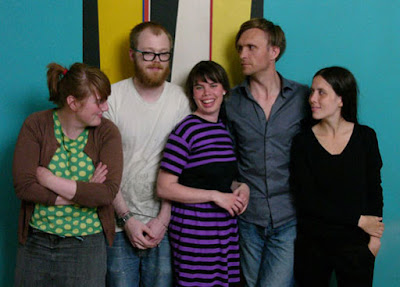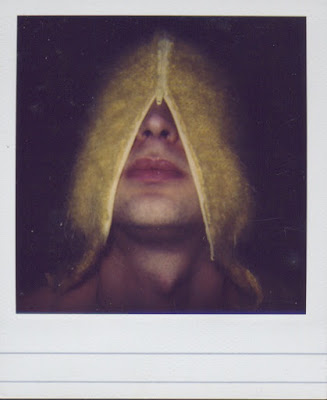Another artist who uses knit to great effect is
Cilla Ramnek. Having studied at the University College of Arts, Crafts & Design in Stockholm, she has shown enormous versatility by designing fabrics for IKEA, producing a couple of craft books, creating artworks for public spaces and exhibiting in Stockholm and Tokyo.
Ramnek has an eclectic but solid approach. Her work is primarily concerned with texture, such as the wonderful beaded glass panels (pictured top), which look like woven fabrics.
 Floor decor, glass mosaic, Saturnus Café, Stockholm
Floor decor, glass mosaic, Saturnus Café, Stockholm
Having the appearance of woven flooring, the floor above is in fact a carefully constructed glass mosaic. There is a tension between the materials represented versus the materials used to convey this. But it is an ultimately comfortable marriage of imagery and medium.
 Souvenires. Mixed media. Exhibition at Teatergalleriet, Kalmar 2005
Souvenires. Mixed media. Exhibition at Teatergalleriet, Kalmar 2005
Her work shows great intelligence.
Ramnek has an ability to make the works welcoming, democratic and not intellectually untouchable, regularly demonstrating an almost folksy feel.
 Lucia, lamp by Cilla Ramnek, exhibited at Materia showroom 2003
Lucia, lamp by Cilla Ramnek, exhibited at Materia showroom 2003
Moving onto her light installations and we see more change and versatility as she happily skips from one discipline to another. Again a connection with stitch, pattern and texture is ever-present. Whilst colourful and densely patterned, the artworks remain conceptually spare, with no overstatement, waste or excess of detail - yet remaining able to demonstrate quite cleverly her playfulness with each medium.


She has an ability to apply pixie magic-dust, quirky individuality and straight, smart logic to any project. Her craft books show a totally unique approach to recycling, hand crafting and self-expression.


The images shown are unique and beautifully stylish yet always unpretentious, which makes the projects feel attainable. The models appear interesting and warm. One imagines her personality is such that she cannot help this human touch creeping into everything she does.
 Ett eget rum, by Cilla Ramnek, Nanna Mörner and Pia Ulin, published by Ica-förlaget 2001.
Ett eget rum, by Cilla Ramnek, Nanna Mörner and Pia Ulin, published by Ica-förlaget 2001.
 My last entry was about an artist concerned with an earthy reality of knit - the processes involved in obtaining the wool, treatment and connection with the animals that provide the wool and our everyday use of the items. This entry is about Vik Prjónsdóttir, an Icelandic collection of designers using myth and legend, storytelling and fantasy alongside the reality of knit as part of their very unique community.
My last entry was about an artist concerned with an earthy reality of knit - the processes involved in obtaining the wool, treatment and connection with the animals that provide the wool and our everyday use of the items. This entry is about Vik Prjónsdóttir, an Icelandic collection of designers using myth and legend, storytelling and fantasy alongside the reality of knit as part of their very unique community. There's something about knitting which often connects us with each other, different cultures or sometimes nods to our folk roots and history. Is it because it was historically a cheap source of clothing and industry, easy to source and make. 'Make do and mend'..? Perhaps because it grounds us? Or is it because we need only do it ourselves as a relaxing, almost meditative past time and are able to take time to reflect and wonder about the rhythmic stitching of other people at other times?
There's something about knitting which often connects us with each other, different cultures or sometimes nods to our folk roots and history. Is it because it was historically a cheap source of clothing and industry, easy to source and make. 'Make do and mend'..? Perhaps because it grounds us? Or is it because we need only do it ourselves as a relaxing, almost meditative past time and are able to take time to reflect and wonder about the rhythmic stitching of other people at other times? Today there's a new tradition emerging from such designers as Vik Prjonsdottir and Cilla Ramnek (previous post). In their hands, the beauty of the ancient craft is being applauded, recorded and pushed into new territory in an elegant yet dynamic manner. In the case of these ground-breaking Icelandic pieces we are asked to re-evaluate the way in which we view knitting.
Today there's a new tradition emerging from such designers as Vik Prjonsdottir and Cilla Ramnek (previous post). In their hands, the beauty of the ancient craft is being applauded, recorded and pushed into new territory in an elegant yet dynamic manner. In the case of these ground-breaking Icelandic pieces we are asked to re-evaluate the way in which we view knitting.  Somehow, this historical grounding feels modern and new to us - perhaps because we have become so used to our narrow expectations of the discipline. We're so excited to see people using knitwear in new ways for fashion, employing modern fibres and new stitch techniques. But here we are being asked to re-think our concepts of how we use it entirely, whilst it is still moving with it's roots firmly in the soil of tradition. We have beautiful throws and quilts, but they're nearly always square and flat... here, the use of knit to warm us is taken in radically different directions drawing us to this fascinating part of the world and it's unique lifestyle.
Somehow, this historical grounding feels modern and new to us - perhaps because we have become so used to our narrow expectations of the discipline. We're so excited to see people using knitwear in new ways for fashion, employing modern fibres and new stitch techniques. But here we are being asked to re-think our concepts of how we use it entirely, whilst it is still moving with it's roots firmly in the soil of tradition. We have beautiful throws and quilts, but they're nearly always square and flat... here, the use of knit to warm us is taken in radically different directions drawing us to this fascinating part of the world and it's unique lifestyle. The twosome blanket is a great innovation based in fact on practicality. In earlier times, when homes were without heating, it was traditional for Icelandic people to share a bed and thus share warmth.
The twosome blanket is a great innovation based in fact on practicality. In earlier times, when homes were without heating, it was traditional for Icelandic people to share a bed and thus share warmth.


























































